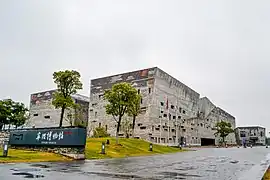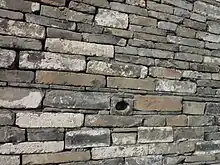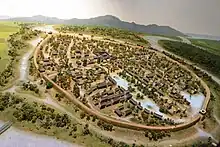Ningbo Museum
The Ningbo Museum (Chinese: 宁波博物馆), also known as the Yinzhou Museum (Chinese: 鄞州博物馆) or the Ningbo Historic Museum (Chinese: 宁波历史博物馆), is a museum in the city of Ningbo in Zhejiang Province, China. It is located in Yinzhou District and opened on December 5, 2008. The museum focuses on Ningbo area history and traditional customs.
 | |
| Established | December 5, 2008 |
|---|---|
| Location | Yinzhou District, Ningbo, China |
| Coordinates | 29.817336°N 121.541178°E |
| Website | www |
| Ningbo Museum | |||
|---|---|---|---|
| Traditional Chinese | 寧波博物館 | ||
| Simplified Chinese | 宁波博物馆 | ||
| |||
Architecture

Ningbo Museum was designed by Wang Shu, the first Chinese citizen to win the Pritzker Architecture Prize in 2012. The design is a conceptual combination of mountains, water and oceans, as the East China Sea has played an important role in the history of Ningbo. Features of Jiangnan residences are integrated into the museum design through decorations made from old tiles and bamboo.
The museum's first floor is constructed as a whole part, while the building starts to tilt on the second floor, giving the whole building a mountain and a boat shape. This design alludes to the geographical feature of Ningbo as well as the importance of overseas commerce in its history, thus making the museum a symbol of Ningbo history and culture.[1]
The outer wall decoration of Ningbo Museum is made in two ways. Some walls are decorated with millions of tiles collected in local areas. This sort of decoration itself was a common way of building an economical house in the old days in Ningbo when cements were not introduced. Other walls are decorated with cement-covered bamboos.[1] It is reported that Ningbo Museum was the first museum built with a large number of used materials.[2] Ningbo Tengtou Pavilion in Shanghai World Expo also employed a similar decoration.[3]
Ningbo Museum won the Lu Ban Prize in 2009, the top architecture prize in China.[4]
Permanent exhibits
Ningbo history exhibit

Located on the second floor of the museum, this is the main exhibit of the museum, showing the history of Ningbo from the Hemudu culture until the Republic of China. Major stories are about ancient cultures, the expansion of the city, overseas commerce, the development of Eastern Zhejiang Scholars and Ningbo Commercial Group. Large amount of artefacts, historic photographs and models are displayed.[5]
Ningbo custom exhibit

This exhibit is located on the third floor of the museum. Wax models and mock buildings and modern electronic techniques are used to show a traditional commercial street in Ningbo. Intangible cultural heritages of the city are also on display.[6]
Bamboo art exhibit
This exhibit is located on the third floor of the museum, displaying old bamboo artefacts donated by Qin Bingnian, the son of the collector, Qin Kangxiang.[7]
Li Yuan Photography Arts Museum
The Li Yuan Photography Arts Museum, also designed by Wang Shu using materials similar to the main Ningbo Museum, opened on September 28, 2013 as a separate pavilion of 1,000 square meters space primarily used for temporary photography exhibits. It is located in the Wu San Fang on the north gate of Luzhou Park. and is named after Chinese photographer Li Yuan who was born in Ningbo.[8]
References
- 宁波有了自己真正的博物馆 (Ningbo owns an authentic museum)
- 宁波博物馆 废旧材料建 (Ningbo Museum: made by used materials)
- 世博宁波案例馆昨揭“盖头” Archived 2016-03-04 at the Wayback Machine (Ningbo Pavilion in Shanghai Expo opened yesterday), cnnb.com.cn, [2010-03-16]
- 宁波博物馆获本年度“鲁班奖” (Ningbo Museum won Lu Ban Prize this year)
- 东方“神舟”——宁波“海上丝路”主题展综述 (City as an Eastern Boat - Theme display of ancient Ningbo as an important node in oceanic silk road)
- “阿拉”老宁波 ——宁波民俗风物陈列 Archived 2013-12-03 at the Wayback Machine (Ala Ningbo residents - Theme display of Ningbo custom and culture)
- 竹刻艺术——秦秉年先生捐赠竹刻珍品展 Archived 2013-12-03 at the Wayback Machine (Bamboo Art - Display of bamboo artefacts donated by Qin Bingnian)
- 摄影家李元摄影艺术馆在鄞州公园内开馆(组图) (Li Yuan Photography Art Museum opens in Zhangzhou Park)